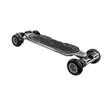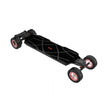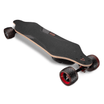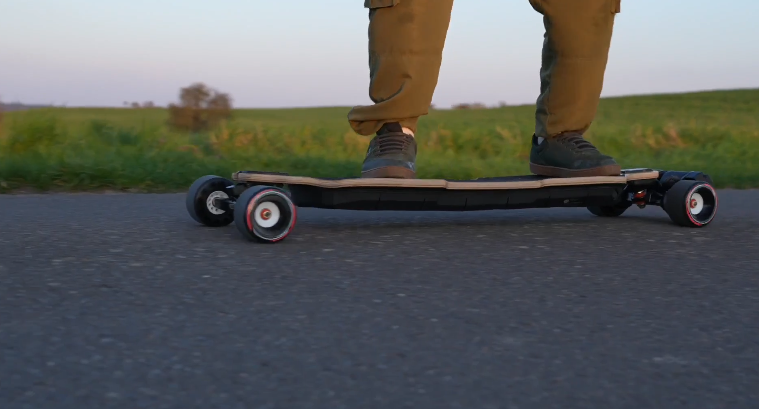| Feature | Hub Drive | Belt Drive |
| Motor Location | In-wheel (integrated) | External (belt-connected) |
| Acceleration | Gradual | Quick |
| Hill Climbing | Limited torque | Stronger torque |
| Wear | Less wear | More maintenance needed |
| Repairs | Easier | More complex |
| Noise Level | Quiet | Noisy |
| Weight | Lighter | Heavier |
| Carrying Ease | Convenient for transport | Bulkier |
| Cost | Generally cheaper | Higher initial/maintenance cost |
| Ideal For | Commuters, beginners | Performance seekers, off-road |
Drivetrain system in electric skateboards refers to the power delivery method from the motor to the wheels, and it will decide the performance of your electric skateboard, in terms of responsiveness and ride feel. Among all those drivetrain systems, there exist two major kinds: hub drive and belt drive. This article will explore the key differences between these two setups to help you make a well-informed choice.
What Is a Hub Drive Electric Skateboard?
The motors in hub drive electric skateboards are inlaid directly into the wheels. In other words, each wheel carries its motor, which allows the immediate transfer of torque from the motor to the wheel. This design is sleek and minimalistic, as there is no extra stuff outside, making it easier to achieve a clean visual aesthetic.
What Is a Belt Drive Electric Skateboard?
Belt drive electric skateboards are powered by motors that are external and connected to the wheels via belts. In this design, there is the incorporation of a pulley mechanism that delivers power from the motor to the wheels, allowing greater flexibility with regard to the placement of motors and performance tuning.
Hub Drive vs. Belt Drive Systems: A Detailed Comparison
1. Acceleration and Speed Capabilities
As for acceleration, the belt drive systems tend to be the stronger of the two, which delivers a more robust initial thrust. The design of a hub drive makes them feel more gradual in terms of acceleration. This could be a consideration depending on what you prioritize in your riding experience.
2. Hill-Climbing Ability
If you ride in a hilly area or plan on tackling steep inclines, the belt drive systems tend to have the upper hand. Their ability to carry more torque and customizable gearing can more effectively handle the climb. Hub drive systems, though some high-quality options can manage hills well, may struggle under heavier loads or steeper grades.
3. Wear and Tear on Components
In terms of wear and tear, generally, the stress experienced by a hub drive system is not that much, since there are fewer moving parts. In the case of belt drive systems, one might need to pay more attention to them, as the belts tend to wear down over time and may need replacement or adjustment for peak performance.
4. Ease of Repairs
Repairing hub drive systems is often easier due to the integrated nature of the components, and fewer parts are involved. If something goes wrong, it may be easier to identify what went wrong and then fix it. Servicing a belt drive system might involve more intricate disassembly and possible adjustments that can intimidate novice riders.
5. Sound Differences
Hub drive electric skateboards are known for their quiet operation. Their motors are enclosed, and that minimizes external noise. When it comes to belt drives, they are more noisy because of the action of friction and the movement of the belts.
6. Overall Weight
Generally, hub drive skateboards are lighter due to the compact nature of their design than their belt-driven counterparts. A difference in weight can make a huge difference in portability and make hub-drive boards easier to transport or carry around.
7. Carry and Transportation Convenience
For any commuters or riders who need to carry their board in and out frequently, the lighter weights in the hub drive systems can make the situation more manageable. A belt drive system may seem manageable at first, but the added weight will be noticeable after longer distances or more frequent use of public transit commutes.
8. Cost Considerations
Hub drive skateboards are generally cheaper due to their simpler construction, while belt drives often require more maintenance and part replacements, therefore being more costly in the long term. Besides, a belt drive e-skateboard might retain value longer due to performance capabilities, but market trends may affect resale values for both.
Who Would Benefit from Hub Drive Electric Skateboard?
- Commuters: If most of your riding is in urban areas with lots of foot traffic and stop-and-go situations, then the quiet operation and gradual acceleration of a hub drive skateboard make it ideal for navigating crowded areas without being a nuisance.
- Beginner Riders: New riders may find hub drives easier to adapt because of the smoother acceleration. Intuitive feel might help build confidence when learning to ride.
- Budget-Conscious Buyers: The price for hub drive skateboards is typically affordable compared to their belt-driven brothers, mainly because of the simpler design and fewer components involved. If efficiency and getting good value for money mean anything to you, then the hub drive is just what you need.
The V series and MINI series of Meepo that we often see are all Hub Drive, including the popular models such as Meepo V5 and Mini 5. They are all Hub Drive-driven and very suitable for beginners, providing sufficient power for urban commuting and leisure riding. They can provide extremely fast speeds and sufficient mileage, which is very suitable for those who need to travel efficiently across the city.
Who Should Choose Belt Drive Electric Skateboard?
- Performance-Oriented Riders: If you're looking for quicker acceleration and higher top speeds, belt drive systems typically outperform hub drives in these areas. They deliver robust initial thrust, making them ideal for riders who crave adrenaline and performance.
- Experienced Riders: Belt drive systems allow for modifications such as changing gear ratios or upgrading components, making them appealing to those who like to personalize their setup.
- Off-Road Adventurers: For riders who intend to take their skateboards onto off-road trails or uneven surfaces, the belt drive tends to handle bumps and obstacles better. The increased torque helps to maintain momentum on rough terrain.
Meepo's Voyager Flow Envy, Hurricane Bamboo, and Vader-Hurricane Pro are all Belt Drive electric skateboard models that can meet the needs of greater power and the ability to ride on a variety of terrains. Their belt drive systems provide the torque needed to tackle hills, making them a great choice for off-road exploration.
Deciding on the Right Electric Skateboard for You
Both hub drive and belt drive electric skateboards have their advantages and disadvantages. While hub drive systems are compact, require less maintenance, and run quietly, belt drive systems excel in acceleration, customization, and hill climbing. Ultimately, it should be a matter of your riding style and how you would intend to use the board. It's best to try both to see what feels right for you. Whatever your choice might be, remember that your safety should be your top priority. Wear protective gear, such as a helmet and knee and elbow pads, and follow local traffic laws to ensure a safe and enjoyable ride.

























